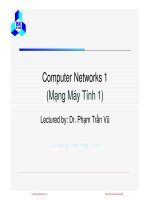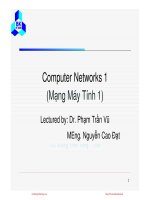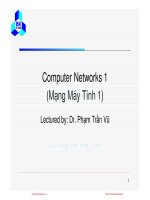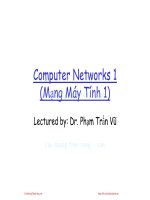Lecture Computer networks 1: Chapter 8 - Phạm Trần Vũ
Bạn đang xem bản rút gọn của tài liệu. Xem và tải ngay bản đầy đủ của tài liệu tại đây (868.84 KB, 49 trang )
Computer Networks 1
(Mạng Máy Tính 1)
Lectured by: Dr. Phạm Trần Vũ
CuuDuongThanCong.com
/>
Chapter 8
Network Security
Computer Networking: A Top Down
Approach ,
5th edition.
Jim Kurose, Keith Ross
Addison-Wesley, April 2009.
All material copyright 1996-2009
J.F Kurose and K.W. Ross, All Rights Reserved
CuuDuongThanCong.com
Introduction
/>
1-2
Chapter 8: Network Security
Chapter goals:
understand principles of network security:
cryptography and its many uses beyond
“confidentiality”
authentication
message integrity
security in practice:
firewalls and intrusion detection systems
security in application, transport, network, link
layers
CuuDuongThanCong.com
/>
Chapter 8 roadmap
8.1 What is network security?
8.2 Principles of cryptography
8.3 Message integrity
8.4 Securing e-mail
8.5 Securing TCP connections: SSL
8.6 Network layer security: IPsec
8.7 Securing wireless LANs
8.8 Operational security: firewalls and IDS
CuuDuongThanCong.com
/>
What is network security?
Confidentiality: only sender, intended receiver
should “understand” message contents
sender encrypts message
receiver decrypts message
Authentication: sender, receiver want to confirm
identity of each other
Message integrity: sender, receiver want to ensure
message not altered (in transit, or afterwards)
without detection
Access and availability: services must be accessible
and available to users
CuuDuongThanCong.com
/>
Friends and enemies: Alice, Bob, Trudy
well-known in network security world
Bob, Alice (lovers!) want to communicate “securely”
Trudy (intruder) may intercept, delete, add messages
Alice
channel
data
secure
sender
Bob
data, control
messages
secure
receiver
Trudy
CuuDuongThanCong.com
/>
data
Who might Bob, Alice be?
… well,
real-life Bobs and Alices!
Web browser/server for electronic
transactions (e.g., on-line purchases)
on-line banking client/server
DNS servers
routers exchanging routing table updates
other examples?
CuuDuongThanCong.com
/>
There are bad guys (and girls) out there!
Q: What can a “bad guy” do?
A: A lot! See section 1.6
eavesdrop: intercept messages
actively insert messages into connection
impersonation: can fake (spoof) source address
in packet (or any field in packet)
hijacking: “take over” ongoing connection by
removing sender or receiver, inserting himself
in place
denial of service: prevent service from being
used by others (e.g., by overloading resources)
CuuDuongThanCong.com
/>
Chapter 8 roadmap
8.1 What is network security?
8.2 Principles of cryptography
8.3 Message integrity
8.4 Securing e-mail
8.5 Securing TCP connections: SSL
8.6 Network layer security: IPsec
8.7 Securing wireless LANs
8.8 Operational security: firewalls and IDS
CuuDuongThanCong.com
/>
The language of cryptography
Alice’s
K encryption
A
key
plaintext
encryption
algorithm
ciphertext
Bob’s
K decryption
B key
decryption plaintext
algorithm
m plaintext message
KA(m) ciphertext, encrypted with key KA
m = KB(KA(m))
CuuDuongThanCong.com
/>
10
Types of Cryptography
Crypto often uses keys:
Algorithm is known to everyone
Only “keys” are secret
Public key cryptography
Involves the use of two keys
Symmetric key cryptography
Involves the use one key
Hash functions
Involves the use of no keys
Nothing secret: How can this be useful?
CuuDuongThanCong.com
/>
11
Symmetric key cryptography
KS
KS
plaintext
message, m
encryption ciphertext
algorithm
K (m)
S
decryption plaintext
algorithm
m = KS(KS(m))
symmetric key crypto: Bob and Alice share same
(symmetric) key: K
S
e.g., key is knowing substitution pattern in mono
alphabetic substitution cipher
Q: how do Bob and Alice agree on key value?
CuuDuongThanCong.com
/>
12
Symmetric key crypto: DES
DES: Data Encryption Standard
US encryption standard [NIST 1993]
56-bit symmetric key, 64-bit plaintext input
Block cipher with cipher block chaining
How secure is DES?
DES Challenge: 56-bit-key-encrypted phrase
decrypted (brute force) in less than a day
No known good analytic attack
making DES more secure:
3DES: encrypt 3 times with 3 different keys
(actually encrypt, decrypt, encrypt)
CuuDuongThanCong.com
/>
23
AES: Advanced Encryption Standard
new (Nov. 2001) symmetric-key NIST
standard, replacing DES
processes data in 128 bit blocks
128, 192, or 256 bit keys
brute force decryption (try each key)
taking 1 sec on DES, takes 149 trillion
years for AES
CuuDuongThanCong.com
/>
25
Public Key Cryptography
symmetric key crypto
requires sender,
receiver know shared
secret key
Q: how to agree on key
in first place
(particularly if never
“met”)?
CuuDuongThanCong.com
public key cryptography
radically different
approach [DiffieHellman76, RSA78]
sender, receiver do
not share secret key
public encryption key
known to all
private decryption
key known only to
receiver
/>
26
Public key cryptography
+ Bob’s public
B key
K
K
plaintext
message, m
encryption ciphertext
algorithm
+
K (m)
CuuDuongThanCong.com
B
- Bob’s private
B key
decryption plaintext
algorithm message
+
m = K B(K (m))
B
/>
27
Chapter 8 roadmap
8.1 What is network security?
8.2 Principles of cryptography
8.3 Message integrity
8.4 Securing e-mail
8.5 Securing TCP connections: SSL
8.6 Network layer security: IPsec
8.7 Securing wireless LANs
8.8 Operational security: firewalls and IDS
CuuDuongThanCong.com
/>
Message Integrity
Allows communicating parties to verify
that received messages are authentic.
Content of message has not been altered
Source of message is who/what you think it is
Message has not been replayed
Sequence of messages is maintained
Let’s first talk about message digests
CuuDuongThanCong.com
/>
40
Message Digests
Function H( ) that takes as
input an arbitrary length
message and outputs a
fixed-length string:
“message signature”
Note that H( ) is a manyto-1 function
H( ) is often called a “hash
function”
large
message
m
H(m)
Desirable properties:
CuuDuongThanCong.com
H: Hash
Function
Easy to calculate
Irreversibility: Can’t
determine m from H(m)
Collision resistance:
Computationally difficult
to produce m and m’ such
that H(m) = H(m’)
Seemingly random output
/>
41
Hash Function Algorithms
MD5 hash function widely used (RFC 1321)
computes 128-bit message digest in 4-step
process.
SHA-1 is also used.
US standard [NIST, FIPS PUB 180-1]
160-bit message digest
CuuDuongThanCong.com
/>
43
Message Authentication Code (MAC)
s = shared secret
message
s
message
message
s
H( )
compare
H( )
Authenticates sender
Verifies message integrity
No encryption !
Also called “keyed hash”
Notation: MDm = H(s||m) ; send m||MDm
CuuDuongThanCong.com
/>
44
End-point authentication
Want to be sure of the originator of the
message – end-point authentication.
Assuming Alice and Bob have a shared
secret, will MAC provide end-point
authentication.
We do know that Alice created the message.
But did she send it?
CuuDuongThanCong.com
/>
48
Playback attack
MAC =
f(msg,s)
Transfer $1M
from Bill to Trudy
MAC
Transfer $1M from
MAC
Bill to Trudy
CuuDuongThanCong.com
/>
Defending against playback
attack: nonce
“I am Alice”
R
MAC =
f(msg,s,R)
CuuDuongThanCong.com
Transfer $1M
from Bill to Susan
MAC
/>
Digital Signatures
Cryptographic technique analogous to handwritten signatures.
sender (Bob) digitally signs document,
establishing he is document owner/creator.
Goal is similar to that of a MAC, except now use
public-key cryptography
verifiable, nonforgeable: recipient (Alice) can
prove to someone that Bob, and no one else
(including Alice), must have signed document
CuuDuongThanCong.com
/>
51









